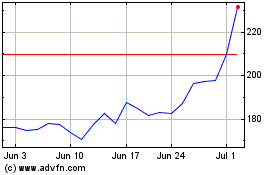Tesla Posts Third Consecutive Quarterly Profit Despite Coronavirus--Update
April 29 2020 - 6:41PM
Dow Jones News
By Tim Higgins
Tesla Inc. reported a surprising first-quarter profit, fueled by
the sale of regulatory tax credits and strong demand for its Model
3 compact car before the coronavirus pandemic shut down the
company's lone U.S. factory in late March.
The electric-car maker said Wednesday it is too soon to say how
the rest of the year might be affected by efforts to quell the
spread of Covid-19, which have roiled automotive markets globally
and raised concerns of a prolonged recession.
"It is difficult to predict how quickly vehicle manufacturing
and its global supply chain will return to prior levels," the
company said. "Due to the wide range of potential outcomes,
near-term guidance of net income and free cash flow would likely be
inaccurate. We will again revisit our 2020 guidance in our Q2
update."
The Silicon Valley company's first-quarter adjusted profit of
$1.24 a share marked the first time in Tesla's 16-year history that
it has recorded three consecutive quarters of profitability. The
result also defied industry analysts, who on average, expected an
adjusted loss of 28 cents a share.
The closely tracked earnings metric excludes stock-based
compensation. On a net basis, the company reported a profit of $16
million attributable to common shareholders.
The quarter was a dramatic improvement from a year ago when the
company posted a first-quarter loss of $702 million as Chief
Executive Elon Musk struggled to export the Model 3 for the first
time and the company saw an erosion of demand in the U.S.
The latest quarter was helped by an uptick in the sale of
regulatory tax credits that Tesla receives for selling electric
vehicles. Revenue from those sales to competitors -- which is
essentially purey profit -- rose to $354 million from $216 million
a year earlier.
The company's shares climbed more than 8% in after-hours
trading.
Mr. Musk spent last year setting up Tesla for continued growth
in 2020 with the opening of a new factory in China and the
introduction of a Model Y compact sport-utility vehicle that
combined were expected to fuel the auto maker's first full-year
profit.
That growth has been in question as pandemic lockdowns shut down
businesses and commerce for much of the world. Tesla's U.S.
assembly plant in Fremont, Calif., stopped production on March 23
under orders from local government.
Mr. Musk had aimed to resume production on May 4 but those plans
were thrown into disarray when authorities in the San Francisco
area on Monday extended the shutdown for businesses through the end
of May.
Over the weekend, some factory employees were instructed to
report to work this week only to be told to wait for further word
on when to show up, workers said.
Tesla said it has the factory capacity in place to deliver more
than 500,000 vehicles even with the production interruptions.
"For our U.S. factories, it remains uncertain how quickly we and
our suppliers will be able to ramp production after resuming
operations," the company said Wednesday. "We are coordinating
closely with each supplier and associated government."
After raising more than $2 billion in cash in February, the car
maker ended the first quarter with $8.1 billion on hand. The
company said in March its cash cushion was enough for it to weather
the economic uncertainty.
"While near-term cash flow guidance is currently on hold, we are
continuing to significantly invest in our product road map and
long-term capacity expansion plans as we have sufficient
liquidity," Tesla said Wednesday.
The company's free cash flow turned negative after a positive
last three months of 2019. The first quarter's rate of burn, almost
$1 billion, exceeded the $516 million expected by analysts surveyed
by FactSet.
Tesla attributed the swing primarily to the interruption of
operations at the end of the quarter as the coronavirus crisis
exploded. It also faced increased spending during the period as it
brought Model Y production online in Fremont and work at the new
China factory.
Mr. Musk has been critical of lockdowns, and Tesla initially
tried to keep its Fremont factory open despite government
instructions. On Twitter late Tuesday night, Mr. Musk vented his
frustrations, writing: "FREE AMERICA NOW."
Deliveries of Tesla vehicles in the quarter rose 40% to 88,400,
helping boost revenue to $5.99 billion from $4.5 billion a year
earlier. Analysts had predicted revenue of $6.1 billion.
The company said its revenue was constrained during the period
"by limitations on our ability to deliver vehicles towards the end
of the quarter."
Write to Tim Higgins at Tim.Higgins@WSJ.com
(END) Dow Jones Newswires
April 29, 2020 18:26 ET (22:26 GMT)
Copyright (c) 2020 Dow Jones & Company, Inc.
Tesla (NASDAQ:TSLA)
Historical Stock Chart
From Mar 2024 to Apr 2024

Tesla (NASDAQ:TSLA)
Historical Stock Chart
From Apr 2023 to Apr 2024
